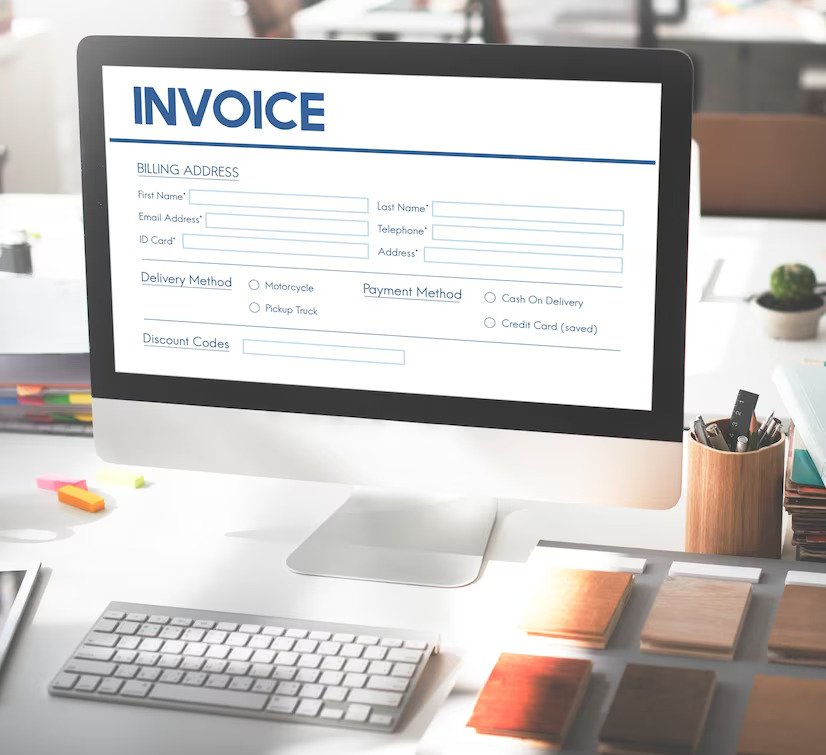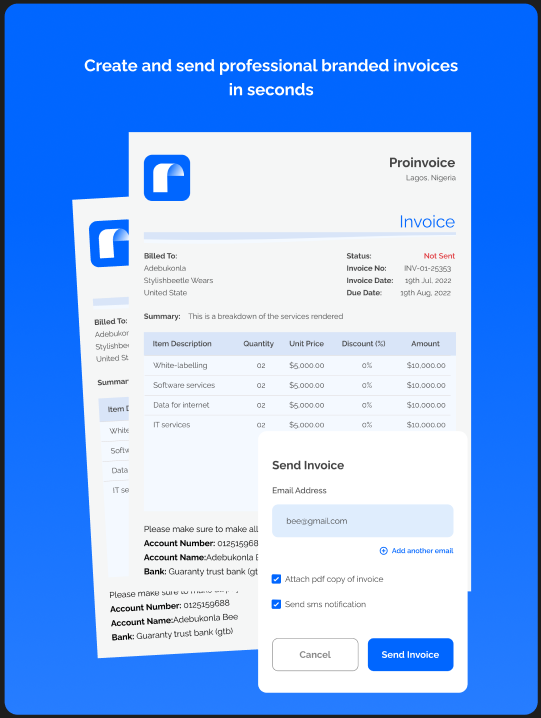1. Introduction
Budgeting and financial planning are the backbone of a successful business. Whether you’re a startup founder, a growing SME owner, or a freelancer managing multiple clients, having a solid financial plan helps you make informed decisions, track cash flow, and remain sustainable in all seasons.
Many businesses in Nigeria and beyond struggle not because their ideas are bad, but because they fail to properly manage their income, expenses, and projections. In this guide, you’ll learn how to create an effective business budget and financial plan that supports both growth and stability.
We’ll also introduce you to ProInvoice, a smart invoicing tool that helps you monitor income, collect payments faster, and stay in control of your finances—an essential tool in any financial plan.
2. What Is a Business Budget and Financial Plan?
2.1 Business Budget
A business budget is a financial roadmap that outlines your expected income and projected expenses over a specific time period—usually monthly, quarterly, or annually.
It helps you:
• Set spending limits
• Allocate resources wisely
• Track your profitability
• Avoid cash flow gaps
2.2 Financial Plan
A financial plan goes beyond just income vs. expenses. It includes:
• Long-term financial goals
• Capital needs
• Investment strategies
• Revenue forecasts
• Risk assessments
• Break-even analysis
Together, your budget and financial plan help you steer your business toward profitability, especially when combined with tools like ProInvoice to ensure real-time payment tracking.
3. Why Every Business Needs a Budget and Financial Plan
Even if you’re running a small service-based business or operating in a volatile economy like Nigeria’s, here’s why budgeting and planning are non-negotiable:
• Improved cash flow control
• Better spending decisions
• Preparedness for slow months
• Easier access to funding or grants
• Ability to measure growth
• Less stress and surprises
4. Step-by-Step Guide to Creating a Business Budget
4.1 Step 1: Determine Your Budgeting Period
Decide if you want to plan monthly, quarterly, or annually. Monthly budgets help track short-term cash flow, while quarterly budgets are good for strategic planning.
4.2 Step 2: List All Sources of Income
Document every way your business earns money:
• Product sales
• Service fees
• Subscription revenue
• Freelance gigs
• Investments or grants
👉 Use a tool like ProInvoice to automatically track paid invoices and calculate monthly income from clients.
4.3 Step 3: List Fixed and Variable Expenses
Fixed costs remain the same every month, while variable costs change depending on your activity level.
Examples:
Fixed: Rent, staff salaries, internet, hosting fees
Variable: Raw materials, logistics, marketing spend, commission
Create a table or spreadsheet separating these two and assigning estimated amounts.
4.4 Step 4: Factor in Unexpected Costs
Always allocate 5–10% of your budget to unforeseen expenses—equipment failure, market price hikes, or emergencies.
4.5 Step 5: Subtract Expenses from Revenue
Use this basic formula:
Profit = Total Revenue – Total Expenses
If your expenses are higher than revenue, adjust before it’s too late. Cut down on non-essentials or increase your pricing. ProInvoice can help track revenue trends from invoicing reports so you know when you’re losing money.
4.6 Step 6: Set Financial Goals and Limits
Example goals:
• Save ₦500,000 in 6 months
• Increase monthly revenue by 15%
• Cut marketing expenses by 10%
• Align your spending plan with these goals. Each goal should be SMART—Specific, Measurable, Achievable, Relevant, and Time-bound.
4.7 Step 7: Monitor and Adjust Monthly
Don’t set it and forget it.
• Compare actual income vs. budget
• Track overspending
• Adjust for seasonal or economic changes
• Keep notes on budget assumptions
ProInvoice simplifies this by showing you who has paid, what’s pending, and how much cash is coming in.
5. Building a Simple Financial Plan for Your Business
Now that your budget is in place, build your financial plan to guide long-term decisions.
5.1 Step 1: Define Your Business Objectives
Start by identifying where you want the business to be in 1 year, 3 years, and 5 years.
Examples:
• Launch in 2 new cities
• Double product offerings
• Hire 5 new staff
• Raise ₦20 million in investor funds
5.2 Step 2: Create Revenue Projections
Forecast expected earnings based on:
• Market size
• Sales data
• Product launch timelines
• New marketing plans
• Break projections down by month and compare them with your actuals using tools like ProInvoice.
5.3 Step 3: Forecast Expenses
Based on your growth goals, estimate what your future expenses will look like. Include:
• New salaries
• Expansion costs
• Product development
• Taxes
5.4 Step 4: Identify Funding Needs
If projections show negative cash flow at any point, you need a funding plan:
• Business loan
• Angel investment
• Grants or pitch competitions
• Bootstrapping from savings
• Having a professional invoicing record from ProInvoice improves your credibility with funders.
5.5 Step 5: Create a Cash Flow Forecast
Cash flow forecasts help you anticipate cash shortages and surpluses.
Map out:
• Incoming payments (from clients)
• Outgoing payments (vendors, rent, payroll)
• Projected bank balance each month
A tool like ProInvoice gives you real-time insights into cash flow, which is critical for growth decisions.
5.6 Step 6: Analyze Break-Even Point
Your break-even point is the moment your revenue covers your expenses.
Break-even = Fixed Costs ÷ (Price – Variable Costs per Unit)
This will help you set sales targets and pricing strategy that sustain the business.
6. Common Budgeting and Planning Mistakes to Avoid
6.1 Ignoring Irregular Income
If your business has seasonal income, budget for the slow months just as much as the peak ones.
6.2 Forgetting Tax Obligations
Many Nigerian SMEs overlook taxes. Set aside a percentage of income monthly (e.g. 7.5% for VAT) to avoid debt.
6.3 Overestimating Sales
Don’t build your plan on “hopeful” figures. Be realistic and use past trends when possible.
6.4 Not Using a Digital Tool
Relying on paper receipts or basic Excel sheets can cause errors. Use tools like ProInvoice to automate and record accurately.
7. Why ProInvoice Should Be a Core Part of Your Budgeting Process
7.1 Get Paid Faster
With clean, professional invoices and built-in payment links, ProInvoice reduces delays in client payments.
7.2 Stay On Top of Receivables
Get notified of overdue payments and automate reminders. This means less chasing and more focus on strategy.
7.3 Access Real-Time Cash Flow Reports
With instant reports, you always know how much you’ve earned and how much is pending.
7.4 Track Performance Against Budget
Because ProInvoice organizes your invoice history by month, client, and payment status, it’s easier to compare actuals vs. projections.
7.5 Improve Financial Record-Keeping
Clean, digital financial records boost your credibility when applying for grants, loans, or investment.
8. Getting Started with ProInvoice
You don’t need to hire an accountant or use complex software. In just a few steps:
• Sign up at https://proinvoice.co/
• Create Your Business Profile
• Send Invoices to Clients and Get Paid Online.
• Track Income and Payment History in Real Time.
• Use Reports to Support Your Budget and Plan.
9. Conclusion
Creating a business budget and financial plan is not just for “big companies.” Whether you’re a solo entrepreneur, digital vendor, service provider, or SME owner, this is the key to profitability, stability, and peace of mind.
Take time to plan your finances, monitor your income, and adjust your spending wisely. Most importantly, use tools that make this process easier and error-free.
✅ ProInvoice gives you everything you need to get paid faster, manage invoices, and track business cash flow—all in one place.
Visit https://proinvoice.co/ to start today.





![Best AI Invoice Automation Software for Small Business USA [2025]](https://proinvoice.co/wp-content/uploads/2025/08/ProInvoice-AI-Invoice.webp)







